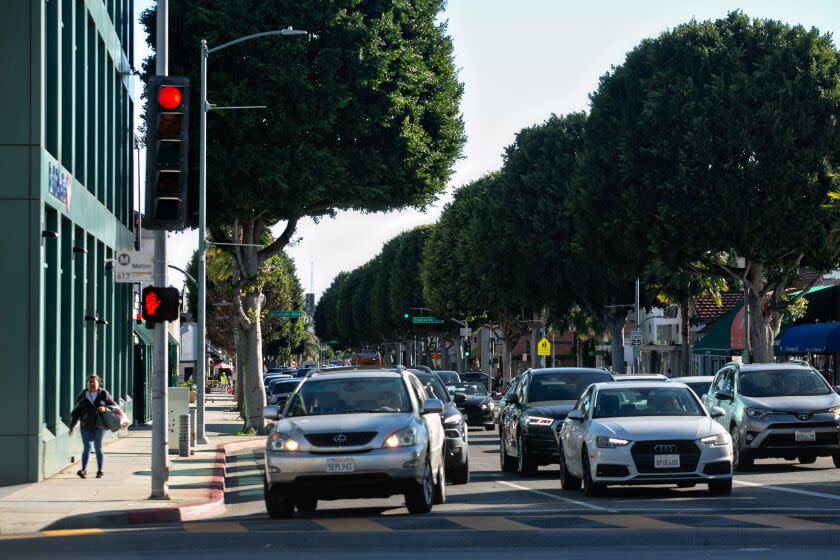Editorial: Beverly Hills is chopping down ficus trees — and replacing them with palms? Bad idea

People grow attached to the trees around them. Trees filter the air, deliver cooling shade, and offer a perch for wildlife. Their leaves shimmer in the sunlight and shimmy in the breeze — a soothing antidote to the noise and traffic.
So when Beverly Hills started chopping down dozens of ficus trees along Robertson Boulevard recently, the sight shocked some of the business owners on the commercial stretch in a city known for its lush plantings and towering palm trees. (City officials say they notified businesses on the street, but some say they didn't receive notice.)
Ficus trees, or Indian laurel figs, have lovely, leafy canopies but are notorious for wreaking havoc on Southern California's urban landscape. The roots, seeking oxygen, thrust themselves out of the ground, upending sidewalks. Not only do they present a tripping hazard to pedestrians, they can damage pipes and plumbing.
The trees are also a financial liability for the city, which has had claims from people injured in accidents caused by the tree roots. Beverly Hills Deputy City Manager Keith Sterling said the city has repaired or ramped the sidewalks to make them traversable but it’s now too difficult to fix the sidewalks without hurting the trees. The city plans to replace them with crape myrtle and Mexican fan palms, which are easier on the infrastructure but offer less protection from the sun.
“It looks like a concrete jungle,” Wendy Klenk, a business owner with an office on Robertson, said of the areas where the trees have been removed.
And as soon as the temperatures warm up, it will feel like a concrete jungle too. Shade from trees lessens the heat island effect when buildings, streets and pavement absorb the sun's heat, making temperatures rise.
As the Southern California climate gets hotter, the region needs more tree canopy cover, which is the percentage of ground covered by leaves and branches of trees when viewed from overhead. Not less, as Beverly Hills is planning.
Not everyone loves the ficus like Klenk does. Property owners on another block of Robertson Boulevard think the trees are a menace and wrote a letter in 2019 to the city’s urban forest manager asking that they be removed.
But do they all need to be cut down? Not all of the trees slated for removal have destroyed the sidewalks. Klenk says the sidewalks around the trees — or where they had been — on her block were in good shape. Sterling said some sidewalks have minimal damage but he knows from experience that the trees can do more damage. Right, but can't the city consider leaving the ones that haven’t damaged the sidewalks, at least for now?
Klenk started a petition protesting the tree removal and has lobbied city officials to stop until the City Council can reevaluate the plan. That's reasonable. About half of the 87 trees scheduled for removal on Robertson Boulevard between Clifton Way and Whitworth Drive have already come down, but it's not too late to save some — and to rethink replacing those already cut down with such poor shade producers.
Palms are a defining feature of the Beverly Hills landscape, but they don't cast much of a shadow. And though crape myrtle is resilient in hot and dry weather, fits nicely on the sidewalks and doesn’t have aggressive roots, it is little more than a large shrub.
And even the city's own Urban Forest Management Plan recommends that existing palms that don’t have historic significance or generate economic value through tourism “should be assessed and selected for strategic removal and replacement with a service-providing shade tree.” Did anyone at City Hall read that document before agreeing to plant more palms?
If the city can start from scratch on Robertson, then why not invest in trees that offer plentiful shade without overpowering the sidewalks?
Species such as African sumac, bottlebrush, mesquite and certain acacias could be good candidates and have roots that generally don’t damage sidewalks, according to Bryan Vejar, the community forestry foreman for Tree People, an environmental advocacy organization.
Other possibilities are the “Bubba" desert willow and "Red Push" pistache, says Janet Hartin, an environmental horticulture advisor with the UC Cooperative Extension in Los Angeles, San Bernardino and Riverside counties.
Both Hartin and Vejar advise planting a mix of replacement trees. Otherwise, a single invasive insect or disease that attacks one species could deforest the entire street.
The city will do a yearlong project replacing sidewalks and curb ramps and installing an irrigation system before replanting. So officials will have ample time to look for street trees that are good for the sidewalks, for humans and for the environment. In the meantime, only residents heartsick over the loss of the ficus trees with be throwing shade on Robertson Boulevard.
This story originally appeared in Los Angeles Times.

